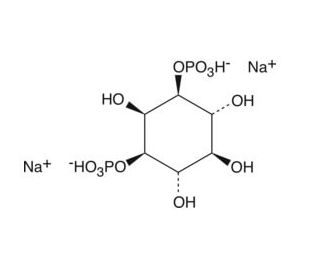

D-myo-Inositol-1,3-diphosphate (sodium salt) (CAS 208584-52-5)
QUICK LINKS
D-myo-Inositol-1,3-diphosphate (sodium salt) serves as a crucial signaling molecule in cellular processes, particularly in the regulation of intracellular calcium levels and phosphate metabolism. This chemical compound acts as an intermediate in the phosphoinositide signaling pathway, where it participates in the synthesis of inositol phosphates and modulates various cellular functions. Upon extracellular stimuli, phospholipase C enzymes hydrolyze phosphatidylinositol 4,5-bisphosphate (PIP2) to generate inositol 1,4,5-trisphosphate (IP3) and diacylglycerol (DAG). Subsequently, IP3 binds to its receptor on the endoplasmic reticulum, leading to the release of calcium ions into the cytoplasm from intracellular stores. Moreover, IP3 can undergo sequential phosphorylation by inositol phosphate kinases to generate D-myo-Inositol-1,3-diphosphate, which further regulates calcium signaling and phosphate metabolism. In research, D-myo-Inositol-1,3-diphosphate (sodium salt) is utilized as a tool compound to investigate the complex mechanisms of phosphoinositide signaling and its implications in cellular physiology. Researchers study its role in diverse cellular processes such as cell proliferation, differentiation, and apoptosis. Moreover, D-myo-Inositol-1,3-diphosphate is employed in studies elucidating the crosstalk between different signaling pathways and its impact on cellular responses. Additionally, it serves as a substrate for enzymatic assays and structural studies aimed at understanding the biochemical properties and regulatory mechanisms of inositol phosphate-metabolizing enzymes. Through its involvement in phosphoinositide signaling, D-myo-Inositol-1,3-diphosphate contributes significantly to advancing our understanding of cellular signaling networks and their dysregulation in various pathological conditions.
D-myo-Inositol-1,3-diphosphate (sodium salt) (CAS 208584-52-5) References
- Inositol phosphate biochemistry. | Majerus, PW. 1992. Annu Rev Biochem. 61: 225-50. PMID: 1323235
- Optimal LC-MS metabolomic profiling reveals emergent changes to monocyte metabolism in response to lipopolysaccharide. | Leacy, E., et al. 2023. Front Immunol. 14: 1116760. PMID: 37033938
- Release of Ca2+ from a nonmitochondrial intracellular store in pancreatic acinar cells by inositol-1,4,5-trisphosphate. | Streb, H., et al. Nature. 306: 67-9. PMID: 6605482
- Inositol trisphosphate and calcium signalling. | Berridge, MJ. 1993. Nature. 361: 315-25. PMID: 8381210
- Regulation of phosphoinositide phospholipases by hormones, neurotransmitters, and other agonists linked to G proteins. | Exton, JH. 1996. Annu Rev Pharmacol Toxicol. 36: 481-509. PMID: 8725399
- Rapid kinetic measurements of 45Ca2+ mobilization reveal that Ins(2,4,5)P3 is a partial agonist at hepatic InsP3 receptors. | Marchant, JS., et al. 1997. Biochem J. 321 (Pt 3): 573-6. PMID: 9032438
- Structure and function of inositol 1,4,5-trisphosphate receptor. | Yoshida, Y. and Imai, S. 1997. Jpn J Pharmacol. 74: 125-37. PMID: 9243320
Ordering Information
| Product Name | Catalog # | UNIT | Price | Qty | FAVORITES | |
D-myo-Inositol-1,3-diphosphate (sodium salt), 100 µg | sc-205284 | 100 µg | $78.00 | |||
D-myo-Inositol-1,3-diphosphate (sodium salt), 500 µg | sc-205284A | 500 µg | $352.00 |
